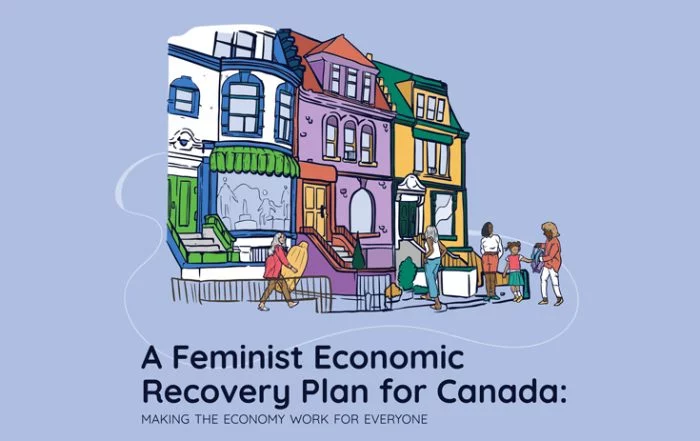Introduction
The COVID-19 pandemic has had gendered effects. Women, especially those who are racialized, Indigenous, low-income, migrants and immigrants, and / or have disabilities, have been particularly susceptible to contracting the disease, as well as to experiencing heightened economic instability, job loss, and curtailed access to services and resources. Trans and gender diverse peoples also face increased risks due to widespread discrimination and stigma. On the other hand, some data suggest that men, particularly racialized men, have been more likely to face serious illness and death from COVID-19.
This primer provides a summary of how gender and its intersections impact the ways the COVID-19 crisis is experienced, including key resources for further reading, and the implications for policy and action during and after the pandemic. It has been updated in July 2021 to add more resources and information to the original April 2020 version.
1. Women are more likely than men to be frontline workers.
Women are more likely than men to be healthcare workers, on the frontline of the pandemic. According to the World Health Organization, across 104 countries, women comprise 70% of health and social care sector workers.[1] In Canada, they are even more represented, at 81% of health care and social assistance workers.[2] This has made women more vulnerable to COVID-19, and as of spring 2021 they made up 51% of COVID-19 cases in Canada. One study in the summer of 2020 found that of all women who tested positive for COVID-19 in Ontario, 36 per cent were employed as healthcare workers, and of those, 45 per cent were immigrants and refugees.[3] However, because there is an underrepresentation of women in leadership, especially racialized and immigrant women, their voices are not often heard in decision- and policymaking.[4]
2. Women, particularly racialized women, are more likely to do high-contact, unprotected, and economically insecure work.
Women and particularly racialized and immigrant women are also concentrated in jobs in services, retail, care, and hospitality sectors. These jobs involve high contact with people, often do not offer paid sick leave, and tend to pay relatively low wages.[5] This has translated to increased risk of contracting COVID-19 for these workers and their families.
Such jobs are also likely to provide precarious and part-time or temporary work, increasing workers’ susceptibility to layoffs and economic insecurity.[6] This latter point means women have been more severely affected by the economic recession caused by COVID-19. Data from Statistics Canada show that women made up 70% of employment losses for Canadians aged 25-64 in March of 2020.[7] Subsequent waves of COVID-19 causing further lockdowns resulted in more lost hours and temporary layoffs for core-aged women than for men, and higher unemployment for young women compared to young men.[8]
Resources (for 1 and 2)
Research and policy
- Canadian Women’s Foundation. (July 2020). Resetting Normal: Women, Decent Work and Canada’s Fractured Care Economy.
- Desjardins, D. and Freestone, C. (November 2020). Canadian Women Continue to Exit the Labour Force. RBC Economics.
- Desjardins, D., Freestone, C. and Powell, N. (July 2020). Pandemic Threatens Decades of Women’s Labour Force Gains. RBC Economics.
- Folbre, N., Gautham, L. and Smith, K. (November 2020). Essential Workers and Care Penalties in the United States. Feminist Economics 27(1-2).
- Holder, M., Jones, J. and Masterson, T. (March 2021). The Early Impact of COVID-19 on Job Losses among Black Women in the United States. Feminist Economics 27(1-2).
- Kikuchi, L. and Khurana, I. (March 2020). The Jobs at Risk Index (JARI).
- Scott, K. (March 20, 2020). COVID-19 crisis response must address gender faultlines. Canadian Centre for Policy Alternatives.
- van Biesen, T. (March 26, 2020). Coronavirus Layoffs Could Erase Many of Women’s Workplace Gains. Catalyst.
- Wenham, C., Smith, J., and Morgan, R. (March 6, 2020). COVID-19: the gendered impacts of the outbreak. The Lancet 395(10227).
Media
- Mojtehedzadeh, S. (March 24, 2020). Cleaners are on the front lines of the COVID-19 crisis. But many work with little protection for less than minimum wage – and they’re scared. Toronto Star.
- Paradkar, S. (July 28, 2020). “It took a pandemic for the country to see what was already broken.” New report offers economic recovery plan with feminist spin. Toronto Star.
- Renzetti, E. (September 24, 2020). The economy won’t heal till women are back at work. The Globe and Mail.
- Scharff, X. (March 12, 2020). Why the Coronavirus Outbreak Could Hit Women Hardest. Time Magazine.
3. Women’s domestic and caregiving burdens have increased.
The pandemic has brought to the fore the importance of public investment in childcare. As countries went into lockdown, women’s domestic work and caregiving burdens increased heavily. When schools and daycares closed and social distancing measures were put into place, caregiving was moved back into the home, and grandparents or other relatives could not assist with care. Sick and / or self-isolating people also needed caregiving. Due to gender norms and roles, women have been doing the majority of this unpaid labour. While both women’s and men’s time spent on domestic work increased during the pandemic, women’s tended to increase more than men.[9] Further, for single mothers, balancing caregiving and paid work is a norm, but during the pandemic this work has been an even heavier load.
As a result, more women than men have left or reduced paid work due to caregiving responsibilities. In the summer of 2020, women’s participation in the Canadian labour force fell to 1980s levels. Between February and October of 2020, 20,600 Canadian women left the labour force while nearly 68,000 men joined.[10] In November 2020, over half of mothers with children under eighteen were working less than half their usual hours, compared to only 41% of fathers.[11] Such caregiving burdens have also resulted in increased reports of mental health issues for parents and particularly for mothers.[12]
Research on gendered effects of the pandemic across multiple countries suggest that having the ability to telecommute reduces these gender differences in employment. However, even for parents who have been telecommuting while taking care of children, mothers still face higher productivity declines than fathers.[13]
Studies show that investing in the care economy (i.e., through publicly funded, affordable and accessible childcare) will boost women’s participation in the labour force as well as ensure that workers in the care sector have good jobs that are paid fairly, resulting in higher quality care services for all.[14]
Resources
Research and policy
- Alon, T. et al. (April 2020). The Impact of COVID-19 on Gender Equality. NBER Working Papers.
- Alon, T. et al. (April 2021). From Mancession to Shecession: Women’s Employment in Regular and Pandemic Recessions. NBER Working Paper.
- Baker, J., Koebel, K. and Tedds, L. (June 2021). Gender Disparities in the Labour Market? Examining the COVID-19 Pandemic in Alberta. University of Calgary: The School of Public Policy Publications.
- Bezanson, K., et al. (April 2020). From Stabilization to Stimulus and Beyond: A Roadmap to Social and Economic Recovery. First Policy Response.
- Collins, C. et al. (July 2020). COVID-19 and the gender gap in work hours. Feminist Frontiers 28(S1).
- De Henau, J. and Himmelweit, S. (June 2020). A Care-Led Recovery from Coronavirus. UK Women’s Budget Group.
- Friendly, M. and Ballantyne, M. (March 24, 2020). COVID-19 crisis shows us childcare is always an essential service. Policy Options.
- Oxfam (June 2020). 71 per cent of Canadian women feeling more anxious, depressed, isolated, overworked or ill because of increased unpaid care work caused by COVID-19: Oxfam survey.
- Ruppanner, L., Churchill, B. and Scarborough, W. (March 26, 2020). Why coronavirus may forever change the way we care within families. The Conversation.
Media
- Kaplan, S. (November 2020). How the caring economy can revive us. Corporate Knights.
- Kennedy, B. (November 2020). Universal child care could generate up to $29 billion a year in tax revenues, new report says. Toronto Star.
- Graves, L. (March 16, 2020). Women’s domestic burden just got heavier with the coronavirus. The Guardian.
- Lewis, H. (March 19, 2020). The Coronavirus Is a Disaster for Feminism. The Atlantic.
4. Gender, race and other social identities shape the risk of serious illness or death from COVID-19.
Some evidence suggests that men have experienced more serious illness from COVID-19 than women. As of June 2021, for every ten women who died of COVID-19 around the world, thirteen men died.[15]
Intersectional analysis is important here. Racialized people are less likely to be able to access healthcare and have access to paid sick leave. They are more likely to work in essential jobs and to be in poorer health due to poverty and inadequate access to healthy foods. Research has found that race plays a significant role in mortality, with one study from the United States showing that Black men have the highest mortality rates from COVID-19. However, Black women showed higher mortality rates than white men and women.[16]
To better understand risks and impacts, it is vital that COVID-19 data disaggregated by sex and gender, as well as other variables such as race, ethnicity, and socioeconomic status, are made available.[17]
Resources
Research and policy
- BMJ GH Blogs (March 24, 2020). Sex, gender and COVID-19: Disaggregated data and health disparities. BMJ Global Health.
- Peckham, H. et al. (December 2020). Male sex identified by global COVID-19 meta-analysis as a risk factor for death and ITU admission. Nature Communications
- Rushovich, T. et al. (April 2021). Sex Disparities in COVID-19 Mortality Vary Across US Racial Groups. Journal of General Internal Medicine.
Media
- Johnson, C.K., Rodriguez, O.R. and Kastanis, A. (June 21, 2021). As US COVID-19 death toll nears 600,000, racial gaps persist. AP News.
5. Vulnerability to domestic abuse and gender-based violence increases.
Isolation and social distancing pose increased dangers to victims of abusive relationships. During a lockdown, victims face more barriers to leaving abusers or to reaching out for help to friends and family. There has also been limited access to domestic violence services such as shelters due to social distancing measures. During the spring of 2020 in China, data indicate that the number of reported domestic violence cases tripled.[18] In Canada at the beginning of the pandemic, the federal government noted that there was a 20-30% increase in domestic violence reports in some regions. It has since announced extra funding for supports and services for gender-based violence, as well as a commitment to a National Action Plan on Gender-Based Violence.[19]
Resources
Research and policy
- Hsu, L-c and Henke, A. (March 2021). The Effect of Sheltering in Place on Police Reports of Domestic Violence in the US. Feminist Economics 27(1-2).
- Westmarland, N. and Bellini, R. (March 19, 2020). Coronavirus lockdown is a dangerous time for victims of domestic abuse – here’s what you need to know. The Conversation.
Media
- Bielski, Z. (March 23, 2020). Self-isolation directives increase risk for women facing domestic violence, experts warn. Globe and Mail.
- Gupta, A.H. and Stahl, A. (March 24, 2020). For Abused Women, a Pandemic Lockdown Holds Dangers of Its Own. New York Times.
- Godin, M. (March 18, 2020). As Cities Around the World Go on Lockdown, Victims of Domestic Violence Look for a Way Out. Time.
- Thompson, N. (Feb.15, 2021). Reports of domestic, intimate partner violence continue to rise during pandemic. CBC News.
6. Access to sexual and reproductive healthcare is curtailed.
During a pandemic, barriers to sexual and reproductive healthcare arise globally. Research has suggested that access to contraception and menstrual products has been curtailed due to supply chain interruptions. There has also been a shortage of services providing sexual and reproductive health care, as resources have been taken away from these programs. Further, people have lacked information about what sexual and reproductive health services are available during quarantine periods.[20] [21] A recent survey of sexual and reproductive health workers in 29 countries found that 86% reported the pandemic decreased access to contraceptive services and 62% reported decreased access to surgical abortion. These results came about due to a lack of political will, the effects of lockdowns, and suspension of sexual education.[22]
Resources
Research and policy
- Ahmed, Z. and Sonfield, A. (March 11, 2020). The Covid-19 Outbreak: Potential Fallout for Sexual and Reproductive Health and Rights. Guttmacher Institute.
- Endler, M. et al. (November 2020). How the coronavirus disease 2019 pandemic is impacting sexual and reproductive health and rights and response: Results from a global survey of providers, researchers, and policy makers. Acta Obstetricia et Gynecologica Scandinavica 100(4).
- Tung, K. et al. (April 2020). Sexual and reproductive health (SRH): a key issue in the emergency response to the coronavirus disease (COVID-19) outbreak. Reproductive Health
- Hussein, J. (March 19, 2020). COVID-19: What implications for sexual and reproductive health and rights globally? Sexual and Reproductive Health Matters.
Media
- Araneta, P. (Jan. 24, 2021). “We’ve had people at our door in tears”: COVID-19 adds barriers to sexual health resources. Global News.
- Beggin, R. (March 22, 2020). Ohio’s attorney general told providers to stop abortions during the coronavirus pandemic. Vox.
- Jalan, S. (March 24, 2020). A Critical Need: Addressing Sexual and Reproductive Health and Rights in the COVID-19 Pandemic. Universal Access Project (Medium).
- UN News. (March 11, 2021). COVID disrupts contraception services, leads to 1.4 million unintended pregnancies, says UNFPA.
7. Indigenous, racialized, low-income, LGBTQ+ and other marginalized groups are more affected.
It is crucial to emphasize that Indigenous, racialized, low-income, LGBTQ+, immigrant, and other marginalized groups have been more affected by the pandemic, as they were already more likely to be in economically insecure and high-risk health circumstances.
The resources linked below point to some different aspects of heightened risk:
- Indigenous and racialized communities as well as immigrants and migrants have been more susceptible to the pandemic’s impacts due to overcrowded housing, unsafe water, and poor access to healthcare and safe employment.
- The pandemic has resulted in palpable racism, hate, and xenophobia against Asian populations.
- Low-income groups are less likely to be able to work from home or have access to paid sick leave, resulting in higher rates of COVID-19.
- Trans and gender-diverse people continue to face high levels of discrimination and stigma, including in healthcare and in bathrooms (where handwashing is done).
- LGBTQ+ people are more likely to face employment instability or insecurity than the general population. LGBTQ+ elders are also more likely to be isolated or living alone.
- Persons with disabilities and chronic health conditions have faced high rates of social isolation and financial uncertainty during the pandemic, leading to increased stress, anxiety, and despair.
Resources
Research and policy
- Acon Health. (n.d.). Trans and Gender Diverse People and COVID-19.
- Chinese Canadian National Council – Toronto Chapter. (March 2021). A Year of Racist Attacks: Anti-Asian Racism Across Canada One Year Into the COVD-19 Pandemic.
- Etowa, J. and Hyman, I. (January 2021). Unpacking the health and social consequences of COVID-19 through a race, migration and gender lens. Canadian Journal of Public Health 112(1).
- Guttmann, A. et al. (September 2020). COVID-19 in Immigrants, Refugees and Other Newcomers in Ontario: Characteristics of Those Tested and Those Confirmed Positive as of June 13, 2020.
- Palmater, P. (March 25, 2020). Canada is Ignoring the Gendered Impacts of COVID-19 on Indigenous Women. Canadian Dimension.
- Pettinicchio, D., Maroto, M., Chai, L. and Lukk, M. (February 2021). Findings from an online survey on the mental health effects of COVID-19 on Canadians with disabilities and chronic health conditions. Disability and Health Journal.
- Prokopenko, E. and Kevins, C. (December 2020). Vulnerabilities related to COVID-19 among LGBTQ2+ Canadians. Statistics Canada.
- Ryan, C., Sabourin, H. and Ali, A. (October 2020). Applying an Indigenous and gender-based lens to the exploration of public health and human rights implications of COVID-19 in Canadian correctional facilities. Canadian Journal of Public Health
- Skye, C. (May 2020). Colonialism Of The Curve: Indigenous Communities & Bad Covid Data. Yellowhead Institute.
Media
- Bascaramurty, D. (March 17, 2020). How the pandemic is highlighting Canada’s class divide. The Globe and Mail.
- Broverman, N. (March 11, 2020). LGBTQ People Especially at Risk for COVID-19, Say 100+ Organizations. Advocate.
- Moody, C. (March 23, 2020). Most Brown and Black Americans Are Exposing Themselves to Coronavirus for a Paycheck. Vice News.
- Serham, Y. and McLaughlin, T. (March 13, 2020). The Other Problematic Outbreak: As the coronavirus spreads across the globe, so too does racism. The Atlantic.
Policy considerations
Considering the above perspectives, the following actions are recommended for policymaking and decision-making during and after the COVID-19 pandemic. Pandemic recovery must use a feminist lens and focus on equity for all groups who have been disproportionately affected. A summary of the Feminist Economic Recovery Plan for Canada developed by GATE in partnership with YWCA Canada can be found below and the full version is available here.
- Ensure marginalized groups have a voice in decision-making around pandemic response. Pay specific attention to the needs and perspectives of women, girls, gender-diverse people, Indigenous, low-income, racialized, LGBTQ+, and other high-risk groups.
- Conduct a gender analysis on all pandemic policy responses, both economic- and health-related. Analysis should be intersectional and consider race, socio-economic status, sexual identity, Indigeneity, and other social demographics. Gender analysis should be considered essential.
- Establish a universal or targeted basic income to ensure that a livable income is not tied to access to work and that unpaid labour is valued.
- Prioritize ensuring that everyone has paid sick leave, high quality health care, and affordable childcare. Lack of paid sick leave and access to care puts an entire population at risk during pandemics.
- Fund and provide extra support for essential reproductive and sexual health services, especially for vulnerable populations. This includes access to maternal and child services, abortion, and women’s hygiene products.
- Fund and provide extra support for shelters and assistance for domestic violence victims and ensure that assistance services are available digitally.
- Promote and campaign for equal domestic work sharing among genders to concretize the importance of reducing these burdens for women.
- Ensure that data collection and analysis on the impacts of the pandemic is disaggregated by gender, sex, race, Indigeneity, disability status, and other social demographics.
Further reading
The following links provide more helpful resources on gender and COVID-19.
- Institute for Gender and the Economy and YWCA Canada: A Feminist Economic Recovery Plan for Canada: Making the Economy Work for Everyone
- Action Canada for Sexual and Health Rights: SRHR and COVID-19
- BC Women’s Health Foundation: Unmasking Gender Inequity
- Centre for Feminist Foreign Policy: Feminist Resources on the Pandemic
- Hawai’i State Commission on the Status of Women: Building Bridges, Not Walking on Backs: A Feminist Economic Recovery Plan for COVID-19
- Feminist Economics: Special Issue on Feminist Economic Perspectives on the COVID-19 Pandemic
- Partnership for Maternal, Newborn and Child Health: Compendium of COVID-19 related partner resources on women’s, children’s, and adolescents’ health
- UNFPA: COVID-19: A Gender Lens: Protecting Sexual and Reproductive Health and Rights, and Promoting Gender Equality
- UN Women: COVID-19: How to include marginalized and vulnerable people in risk communication and community engagement
- Women Entrepreneurship Knowledge Hub: COVID-19 Resources for Women Entrepreneurs in Canada
- XY Online: Gender and the COVID-19 pandemic
Téléchargez le pdf en français ici.
________________________
Policy brief prepared by:
CARMINA RAVANERA OF THE INSTITUTE FOR GENDER AND THE ECONOMY AT THE ROTMAN SCHOOL OF MANAGEMENT, UNIVERSITY OF TORONTO, UNDER THE SUPERVISION OF PROFESSOR SARAH KAPLAN.
References
[1] Boniol, M., et al. (2019). Gender equity in the health workforce: Analysis of 104 countries. World Health Organization. Retrieved on March 25, 2020 from https://apps.who.int/iris/bitstream/handle/10665/311314/WHO-HIS-HWF-Gender-WP1-2019.1-eng.pdf?sequence=1&isAllowed=y
[2] Statistics Canada (2019). Employment by class of worker, annual (x 1,000). Retrieved on March 25, 2020 from https://www150.statcan.gc.ca/t1/tbl1/en/tv.action?pid=1410002701&pickMembers%5B0%5D=1.1&pickMembers%5B1%5D=3.15&pickMembers%5B2%5D=4.3
[3] Guttmann A. et al. (2020). COVID-19 in Immigrants, Refugees and Other Newcomers in Ontario: Characteristics of Those Tested and Those Confirmed Positive, as of June 13, 2020. Retrieved on May 20, 2021 from https://www.ices.on.ca/Publications/Atlases-and-Reports/2020/COVID-19-in-Immigrants-Refugees-and-Other-Newcomers-in-Ontario
[4] Wenham, C., Smith, J., and Morgan, R. (March 6, 2020). COVID-19: the gendered impacts of the outbreak. The Lancet 395(10227).
[5] Scott, K. (March 20, 2020). COVID-19 crisis response must address gender faultlines. Canadian Centre for Policy Alternatives. Retrieved on March 25, 2020 from http://behindthenumbers.ca/2020/03/20/covid-19-crisis-response-must-address-gender-faultlines/
[6] Moyer, M (2017). Women and Paid Work. Statistics Canada. Retrieved on March 26, 2020 from https://www150.statcan.gc.ca/n1/pub/89-503-x/2015001/article/14694-eng.htm
[7] Statistics Canada (2020). Labour Force Survey, March 2020. Retrieved on May 19, 2021 from https://www150.statcan.gc.ca/n1/daily-quotidien/200409/dq200409a-eng.htm
[8] Statistics Canada (2021). Labour Force Survey, April 2021. Retrieved on May 19, 2021 from https://www150.statcan.gc.ca/n1/daily-quotidien/210507/dq210507a-eng.htm
[9] Kabeer, N., Razavi, S., van der Meuelen Rodgers, Y. (2021). Feminist Economic Perspectives on the COVID-19 Pandemic. Feminist Economics 27(1-2), 1-29.
[10] Desjardins, D. and Freestone, C. (2020). Canadian Women Continue to Exist the Labour Force. RBC Economics. Retrieved on May 19, 2021 from https://thoughtleadership.rbc.com/canadian-women-continue-to-exit-the-labour-force/
[11] Statistics Canada (2020). Labour Force Survey, November 2020. Retrieved on May 19, 2021 from https://www150.statcan.gc.ca/n1/daily-quotidien/201204/dq201204a-eng.htm
[12] Oxfam (2020). 71 per cent of Canadian women feeling more anxious, depressed, isolated, overworked or ill because of increased unpaid care work caused by COVID-19: Oxfam survey. Retrieved from https://www.oxfam.ca/news/71-per-cent-of-canadian-women-feeling-more-anxious-depressed-isolated-overworked-or-ill-because-of-increased-unpaid-care-work-caused-by-covid-19-oxfam-survey/
[13] Alon, T. et al. (2021). From Mancession to Shecession: Women’s Employment in Regular and Pandemic Recessions. NBER Working Paper. Retrieved on June 28, 2021 from https://www.nber.org/system/files/working_papers/w28632/w28632.pdf
[14] de Henau, J. and Himmelweit, J. (2021). A Care-Led Recovery From Covid-19: Investing in High-Quality Care to Stimulate And Rebalance The Economy. Feminist Economics 27(1-2).
[15] The Sex, Gender and COVID-19 Project (2021). Retrieved on July 5, 2021 from https://globalhealth5050.org/the-sex-gender-and-covid-19-project/the-data-tracker/
[16] Rushovich, T. et al. (2021). Sex Disparities in COVID-19 Mortality Vary Across US Racial Groups. Journal of General Internal Medicine.
[17] Allotey, P., Reidpath, D.D. and Schwalbe, N. (2020). Are men really that much more likely to die from coronavirus? We need better data to be certain. The Conversation. Retrieved on May 19, 2021 from https://theconversation.com/are-men-really-that-much-more-likely-to-die-from-coronavirus-we-need-better-data-to-be-certain-141564
[18] Allen-Ebrahimian, B. (March 7, 2020). China’s domestic violence epidemic. Retrieved on March 26, 2020 from https://www.axios.com/china-domestic-violence-coronavirus-quarantine-7b00c3ba-35bc-4d16-afdd-b76ecfb28882.html
[19] Patel, R. (April 27, 2020). Minister says COVID-19 is empowering domestic violence abusers as rates rise in parts of Canada. Retrieved on June 2, 2021 from https://www.cbc.ca/news/politics/domestic-violence-rates-rising-due-to-covid19-1.5545851
[20] Hussein, J. (2020). COVID-19: What implications for sexual and reproductive health and rights globally? Sexual and Reproductive Health Matters.
[21] Marie Stopes International (2020). Resilience, Adaptation and Action : MSI’s Response to COVID-19. Retrieved on May 20, 2021 from https://www.msichoices.org/media/3849/resilience-adaptation-and-action.pdf
[22] Endler, M. et al. (2020). How the coronavirus disease 2019 pandemic is impacting sexual and reproductive health and rights and response: Results from a global survey of providers, researchers, and policy makers. Acta Obstetricia et Gynecologica Scandinavica 100 (4), 571-578.







